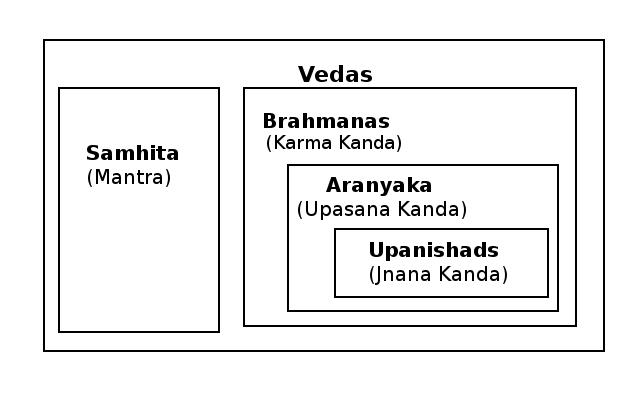Vedanta (or Upanishad) literally means the end of Veda or the concluding portion of Vedas. Now this can have two meanings:
1) If Veda considered a book then Vedanta it's concluding chapters. In this case, there is virtually no difference between the two. So, there is no need to mention them separately when they are mentioned together.
2) Vedanta are the supplementary texts that are appended to the ends of Veda at a later period. Even saints like Rishi Aurobindo agrees with the Upanishadic period being much later to the Vedic period.
The conclusion 2 appears to me as much more reasonable.
Now, while its virtually impossible (IMHO) to prove that Upanishads or Vedanta are also a part of Vedas (i.e they are Sruti or heard by Rishis ) but indications which point to the opposite direction are many.
Therefore the Yogis that want rewards meditate Her, Who is of the
nature of Vidyâ and Who is devoid of attributes. The best Munis, the
knowers of the truths of Vedanta meditate on Her as formless,
immutable, stainless, omnipresent Brahmâ devoid of all Dharma. She is
described in some Vedas and Upanishads as full of Light (Tejas)
The Brâhmins, versed in the Vedas and Vedantas, are objects of
venerations and must be worshipped. Give, then, them always according
to merits, cows, lands, gold, etc. Don’t worship any Brâhmin who is
illiterate. Don’t give to illiterates more than their belliful wants.
The Devi BhAgabatam, Book 3, Chapter 1.
Now, if Vedanta=Vedas, then there remains no need to mention them separately in the same sentence. Right? But as you can see they are mentioned separately.
Even the Brihad Aranyaka Upanishad mention Vedas and Upanishads separately while mentioning them together. Following are the relevant verses from the Upanishad.
"As from a fire kindled with wet fuel various kinds of smoke issue
forth, even so, my dear,
the Rig—Veda, the Yajur—Veda, the Sama—Veda, the Atharvangirasa, history (itihasa), mythology (purana), the arts (vidya), the
Upanishads, verses (slokas), aphorisms (sutras), elucidations
(anuvyakhyanas) and explanations (vyakhyanas) are like the breath of
this infinite Reality. From this Supreme Self are all these, indeed,
breathed forth. (4.5.11)
Janaka, Emperor of Videha, rose from his lounge, humbly approached
Yajnavalkya and said: "Salutation to you, O Yajnavalkya. Please
instruct me." Yajnavalkya said: "Your Majesty, as one who wishes to go
a long distance would procure a chariot or a ship, even so you have
fully equipped your mind with so many secret names of Brahman. You are
also honoured and wealthy; you have studied the Vedas and heard the
Upanishads. But do you know where you will go when you are released
from this body?"
Verses from Brihad Aranyaka Upanishad,(4.2.1) .
The Vyasa Smriti also does the same:
Then having recited the Gayatri, the twice-born ones should commence
the study of the Vedas. Having studied portion of the Saman, Yajus,
and Atharvan, they should commence reading the Itihasas, Puranas and
Upanishads, either entirely, or in parts, if a complete perusal is not
feasible. This should be done every day. (910) (Vyasa Smriti)
So, option 2 is much more reasonable. They are appended later to the Vedas by the teachers so that the students can master the terse content of Vedas easily.
They are like appendices to the Vedas but very important texts none the less.

